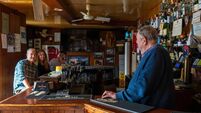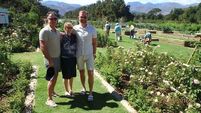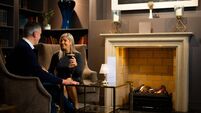Books: An abandoned cottage, and the remarkable man who lived in it
Mick Murphy's cottage in the book Abandoned Ireland 2
A new book allows readers to discover the hidden places – cloaked by ivy, veiled in dust – and glimpse the faded beauty of Ireland’s abandoned buildings.
Written and photographed by Rebecca Brownlie. Abandoned Ireland 2 explores Ireland’s most fascinating forgotten sites as nature threatens to reclaim them, from crumbling cottages and silenced mills to deserted mansions and imposing castles.
In this extract, Rebecca visits two such places, in Kerry and Cork.
Mick Murphy’s House, Kerry
If there ever was a house that could inspire me to write a book, it would be this one, and that is all to do with its owner, Mick Murphy.
I first heard about Mick one day when I was in a bookshop in Dromore in my native Co. Down, signing copies of my first book, Abandoned Ireland.
A man came in and introduced himself as Kieran Murray. He mentioned a man from West Kerry he had photographed years ago, known as the ‘Iron Man’. He told me this man had won the Irish cycling race the Rás Tailteann in the 1950s and had a unique training regimen that involved drinking cow’s blood by nicking the animal’s vein with his penknife and drinking it straight from the source.
I was intrigued. It transpired that Mick had passed away a few years earlier, but we thought it would be worth contacting his family to see if his house was still standing and if I could visit and learn more about him.
I reached out to his cousin Ciaran, who told me Mick’s house was indeed still standing, and that he owned it. I asked if I could meet him to discuss photographing the house and was extremely grateful when he agreed.
I had never been to that part of west Kerry and the scenery was breathtaking, the sea and mountains creating a stunning backdrop. The air felt different, almost otherworldly.
When I met Ciaran at a marina, I showed him my first book. This seemed to put his mind at ease as he began to understand the vision I had for the project involving Mick.
He said the house had been emptied, with Mick’s belongings stored away safely. I could look at the house that day, but return at a later date to do the documentation. This would allow him time to place some items back in the house as they were when Mick was alive. This made my day!
We took a short trip on winding mountain roads to Mick’s house. I had read a lot about him and felt a little emotional when we arrived at his cottage. When you research these properties you can’t help but feel a connection to the lives and stories behind them.
We stood outside the gate for a while as Ciaran shared stories about his cousin. Mick had grown up in the house with his parents and a younger brother, who tragically passed away at a young age. His mother homeschooled him, teaching him how to read and write. Mick developed a love for reading, spending hours immersed in books.
He was a jack of all trades, teaching himself various skills, including farming, juggling, fire-eating, cycling, wrestling, boxing, running and bricklaying. Whatever he learned, he mastered.
As I listened, I absorbed every detail, eager to learn more. I regretted not having had the chance to meet Mick in person, a common feeling when documenting a house.
In June, I made my second trip to west Kerry, filled with anticipation. I met Ciaran at Mick’s house. As I gazed at some hand-painted designs on the low garden wall, I asked if Mick was the artist, but Ciaran informed me it was actually Mick’s mother who had covered both external and internal walls with her beautiful creations. Intrigued, I couldn’t wait to see more.
We stepped inside the modest cottage. Despite its small exterior, the inside was surprisingly spacious. The ground floor had two rooms, with a flight of stairs leading up.
I noticed weights in the living room and various items scattered around, books, pictures, a dartboard, juggling sticks and circus balls. It was clear that Mick had a rich and colourful past.
One story that truly showcased Mick’s determination and grit was his experience in the famous Rás Tailteann. A talented cyclist, he was leading the 1958 race when his front wheel gave out, forcing him to stop. Undeterred, Mick lifted his bike onto his shoulder and began running.
He came upon a farmer watching the race at the side of the road and holding a bike, so Mick set down his own damaged one and hopped onto the farmer’s. He later said it was a big, awkward, girly-looking bike, but that didn’t stop him; he pedalled furiously to catch up with his competitors.
He made it to Cork, where his team car met him and he was able to swap the bike for the team spare.
With 40 miles to go, Mick caught the rest of the pack and crossed the finishing line without losing any time. But there’s more to the story.
Next day, Mick suffered a serious crash on the fourth stage of the race. Speeding downhill at 50mph, he hit a bridge and came flying off the bike, injuring his shoulder and suffering a concussion. Another rider offered his bike to Mick, gave him a slap on the chin and said, ‘Get on it,’ urging him to continue. Mick not only finished, but went on to win the race.
I asked Ciaran how Mick had passed. I was not prepared for what I heard. Mick was best friends with Ciaran’s father – they were cousins who grew up together. When Ciaran’s father passed away unexpectedly, he drove over to tell Mick, who was devastated.
The morning of the funeral, Ciaran arrived to pick up Mick, but the front door of the house was slightly ajar and he was nowhere to be found. Despite his efforts to locate him, there was no sign of Mick, and the funeral proceeded without him.
Ciaran was deeply worried, as this was very unlike Mick, and he called again to the house after the funeral. He even phoned the local gardaí to ask if they’d seen him.
Across from Mick’s house is a small ruin of a stone house. Ciaran noticed the field gate to it was wide open. His suspicions led him there and he found Mick lying behind the stones, wearing the same clothes he’d had on the day he’d heard about Ciaran’s father.
It seems Mick had gone there after receiving the news and passed away from a broken heart. He was buried near the house in his parents’ grave. I paid my respects before leaving.
Visiting Mick’s house and learning about his life was an honour, and the experience will stay with me forever. He was truly inspirational; individuals like him are rare indeed.
I will always remember my visit to Kerry, and the hospitality and kindness shown to me by Ciaran.
Spike Island, Cork
Now an internationally recognised tourist attraction, Spike Island may seem like an odd inclusion in a book called Abandoned Ireland 2.
However, not all of the site has been rehabilitated. I contacted those managing the island and asked if there were any ‘unseen’ or abandoned parts of the prison I could document, they told me they had an old prison block that is not included in tours and some very old tunnels that people do not get to see.
The history of human occupation on Spike Island began over 1,300 years ago when St Mochuda founded an early Christian monastery there. Despite being ravaged by Vikings in the 9th century, reports indicate that a monastic settlement persisted on Spike until the 16th century.
Better known is the island’s long history as a place of confinement, punishment and defence. Originally called Fort Westmoreland, it was used by the British Army to defend Cork harbour from potential invaders. Its strategic location within the harbour made it ideal for fortifications.
The island’s iconic 18th century star-shaped fort still stands as a reminder of this military past.
In 1847, at the height of the Famine, the island was used as a jail to house convicts and political prisoners. Conditions were harsh and overcrowded, with poor sanitation and inadequate food and medical care leading to high mortality rates among inmates. The prison population swelled as the British government sought to quell dissent and maintain control over the Irish people.
In the Irish War of Independence, Spike Island again became a place of detention, this time for republicans and other political prisoners. It was a symbol of British oppression and resistance for many nationalists, exacerbated by incidents like the death of prisoner Patrick White in 1921.
One afternoon, some inmates were playing a game of hurling when the ball went into barbed wire surrounding the yard. Patrick, of Meelick, Co. Clare, ran over to fetch it and a sentry shot him. Paddy’s comrades went to him and said a prayer, but he died soon after.
After Ireland gained independence in 1922, Spike was taken over by the Irish Free State and continued to be used as a prison. It was also used as a military base and training facility for the Irish Defence Forces. In the late 20th century, the island was decommissioned as a prison and visitors can now explore its rich history.
Abandoned Ireland 2, published by Merrion Press.







 App?
App?


